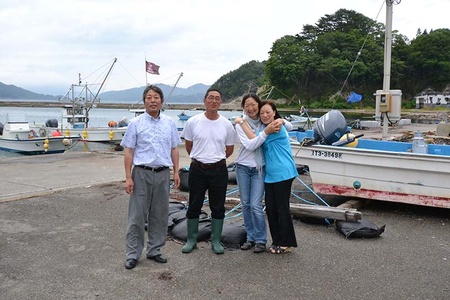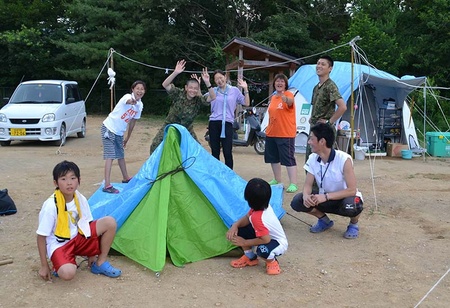It is important for the world to know that the recovery effort for the people of Tohoku is still an ongoing, painful process that is still years away from ever returning to “normal”.
Sadly, in a world where there are so many disasters competing for media attention, the survivors of Tohoku Region in northeastern Honshu, are becoming a somewhat “forgotten” people.
Canadians like Maynard and Blaise Plant of the Sendai-based band, Monkey Majik , as well as Vancouver artist and volunteer extraordinaire Linda Ohama, based in Onomichi, have been tirelessly raising money and awareness of the on-going plight of the people of Tohoku since the disaster.
I caught up with Linda online a couple of weeks ago.
How is the recovery effort in Tohoku going? When were you there last?
I am here in Tohoku now based in Sendai but traveling throughout Tohoku. Last weekend, I was in Minamisoma, Fukushima. Today, I will be in Natori, Watari, Miyagi, and, from Nov. 3rd to 6th, I will be traveling to Miyako and Otsuchi, Iwate.
How is the recovery going? There are some new paved highways, lots of huge hills of “gareki ” (tsunami debris), fields full of weeds that have grown over the cement foundations left in destroyed villages, which makes them seem less barren, cemetery sites full of many new “ohakas ” (graves), strings of garbage trucks carrying debris somewhere on all the roads all day long and lots of recovery happening at the grassroots level in small communities like bakeries rebuilding and baking their famous cookies again, and huge fishing ships coming back into Onagawa Port to unload their deep sea catches of tuna again.

Fishermen in Otsuchi....they showed her the ruined situation of their industry and their town. They are a location that was badly hit...the worst of all the towns hit by the tsunami. They still have so much clean-up and work to do.
BUT…
There is a quiet stress and worry about people’s futures. Will they be able to get a job again? Will they be able to afford a house again and move out of temporary housing projects? Will they have enough energy and money to get through another winter? Will life ever return to normal? What’s happening to Fukushima and the radiation? Will they be able to keep up paying their mortgage payments for the house that has been completely destroyed by the tsunami with only small signs that it ever existed?
Everywhere I go in all three kens , there is a sense of growing isolation, despair, and fear of their future. People are afraid to go out, so they stay inside alone. Why are they afraid? I am not sure except that living in these types of conditions with so many hundreds together makes for social problems. Japanese people are nervous about “what people might think or say” about them, so they tend to stay to themselves which nowadays means in a small temporary home that shares its thin walls with the next door residents.
Just how long can people live under these conditions without suffering emotional stress which can lead to serious problems such as a rise in suicides.
Some very strong cultural characteristics and traditions are what is helping the Tohoku people feel some power and strength to carry on positively, but these character traits also give them more stress in some instances. It is a delicate balance for certain and hopefully most people can keep enough balance to keep trying and not to give up.
As the second winter begins in Tohoku since the tsunami, I know that many organizations and volunteer centers are preparing for “depression” and rise in suicides.
In Otsuchi, one of their biggest volunteer efforts is visitations. Just to listen to people who feel confined in their temporary homes. In Otsuchi, the temp houses are far from the town center (which barely exists) so if they don’t have a car to get to a store, too bad.
Is there any sense of “normalcy” there in the worst affected areas? Can you paint a picture of what those areas still look like?
“Normalcy”? Depends on where you go and the situation they live with. For instance, in Sendai, the people of Arahama, Yuriage, Watari, etc. are all living in urban temporary housing shelter projects. Some are vacated old rundown apartment housing (e.g. Japan Railroad employee housing), and others are new, pre-fabricated small row housing units.
In Fukushima, around Iwaki City and Minamisoma areas, many of the towns have been evacuated because of the high level of radiation contamination. These people have been moved to temporary housing projects in “safer” areas. What is safe and what is not, is a very big unknown since information regarding this is very unreliable and constantly changing. What used to be considered safe, they later find is unsafe, so they start moving the people out months later. It is very weird.
Like Odaka, there are ghost towns and when I went inside the boundaries to see some of these places, it is a very eerie feeling to hear no traffic (but the traffic lights still change from green to red), no children laughing, no dogs barking, only lots of birds chirping. Probably in these places, we hear the birds because the other sounds have disappeared. I think Japan and the world will get a shock in the future findings in Fukushima, sadly to say.
And then there are places like Otsuchi, Iwate ken where the damage was so extreme and their location is more remote that even today, their town is not cleaned up. Half buildings are still standing, there is still lots of clean-up to do, and regular services have not returned except for temporary shopping centers, temporary convenience stores, but most things are temporary like trailers.
Even though the situation for clean-up has a long way to go in Otsuchi compared to Onagawa which is like a barren moonscape as everything has been demolished and trucked away to the huge mountains of “gareki” (tsunami debris)—Otsuchi’s spirit is very strong. Ordinary people just keep on going and keep on volunteering in very poor conditions compared to a place like Sendai.

Onagawa temporary tent housing last summer (July 2011). They invited Linda to share their tent community with her little tent. They welcomed her with open arms, even the Jieitai helped her set-up. The kids all could not believe how small her tent was.....so everyone wanted to try going inside! She said, "Since that time, I have made so many good friends from these Onagawa tsunami victims...that to today, we still stay in touch and I try to see and help whenever I get close to Onagawa."
© 2012 Norm Ibuki






